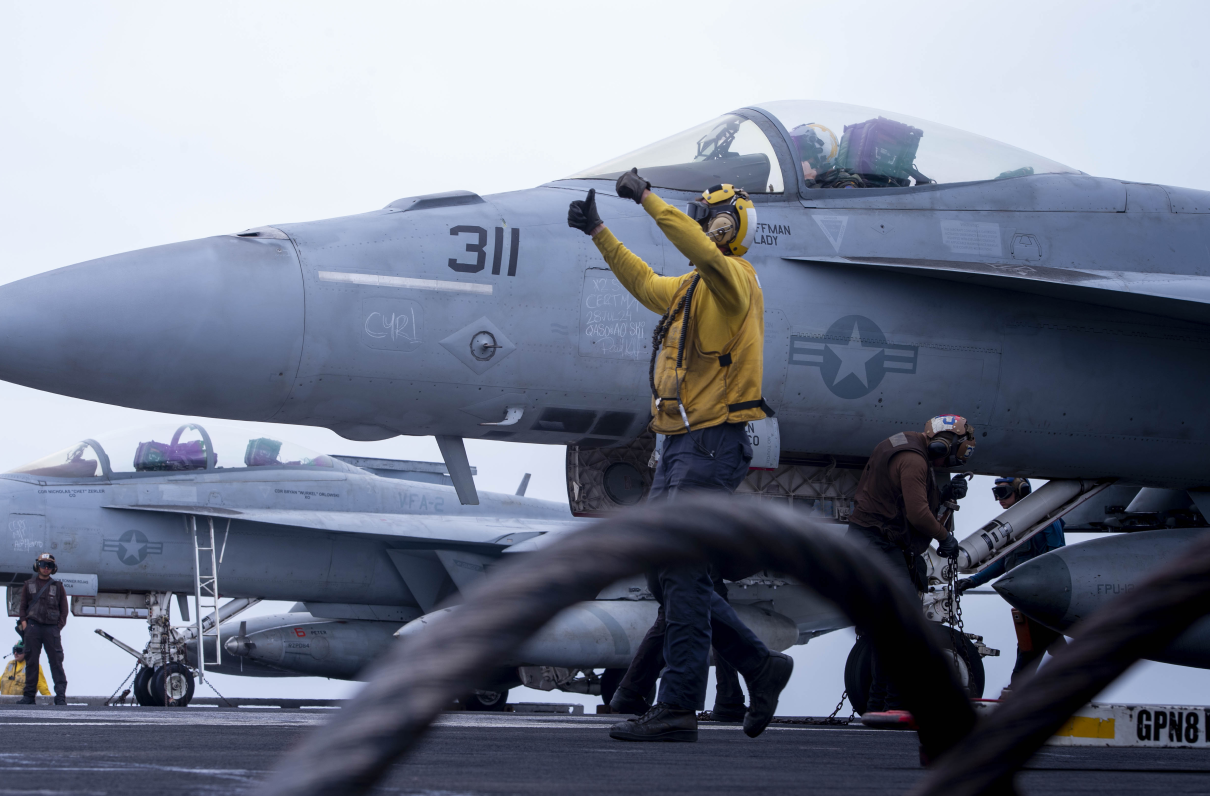This article by Diana Stancy originally appeared on Military Times, the nation's largest independent newsroom dedicated to covering the military and veteran community.
The Navy will now require naval aviators to serve past their minimum service requirement in order to complete their second, two-year sea tour — the sea service’s latest attempt to boost retention in the aviation community, according to an internal briefing document obtained by Navy Times.
The policy applies to officers serving in their first shore tour with a projected rotation date of October 2025 and beyond, and is being implemented due to “personnel shortages across second sea duty billets,” the Naval Air Forces document states.
“This policy increases warfighting readiness by reducing billet turnover rates at sea, and ensuring more of the Navy’s highest priority billets are filled,” the briefing states.
Naval Air Forces confirmed the authenticity of the document to Navy Times.
Roughly a quarter of unrestricted line aviators request to leave the Navy once they reach their minimum service requirement, sometimes in the midst of that second two-year sea tour — an issue the Navy attributes to extended training pipelines and first sea duty tour extensions in some instances.
[RELATED: Newly Trained Air Force Pilots May Take on Jobs Outside Fighters and Bombers]
While Navy Personnel Command has historically signed off on such mid-tour separation requests, Navy pilots and naval flight officers will now fulfill the entire length of a second sea tour prior to departing the service.
“Aviation [unrestricted line] communities are tasked with filling 904 second sea duty billets; current inventory and separation timing have led to approximately 19% of these billets remaining unfilled and 60-70% of these billets turning over annually resulting in decreased operational readiness in key billets,” the document states. “This has been mitigated by early departures from first shore tours, which impacts retention and is unsustainable long term.”
Most officers will be forced to stay in uniform for less than a year more under the new policy, according to Naval Air Forces spokesperson Cmdr. Beth Teach.
The policy also aims to allow more junior officers to complete their full shore-duty, rather than stepping in to fill empty at-sea billets caused by the departing aviators, she said.
“We are in a warfighting business and this is one way that we’re going to continue to increase readiness,” Teach told Navy Times. “We understand that there are concerns, and we’re communicating this more than a whole year in advance, so that people can ask questions and plan their careers. Ultimately, it reduces turnover and creates opportunity for more [junior officers] to complete their shore duty in the future.”
[RELATED: Innovative Programs Help Navy Meet Recruiting Goal for First Time in Years]
In a list of questions and answers included in the document, Naval Air Forces says that it is legal for the Navy to require officers to serve past their minimum service requirement to fulfill the prescribed tour length in the event of personnel shortages.
“In accordance with MILPERSMAN 1301-108, and higher-level instructions, if determined by competitive category or designator that significant personnel shortages are a compelling military necessity for retention, then an Officer may be retained until the completion of the Prescribed Tour Length written in approved orders,” the document states.
Word of the policy change spread online Tuesday, and Instagram pages dedicated to the world of junior Navy officers soon went to work with memes related to the news.
View this post on Instagram
The head of naval aviation, Vice Adm. Daniel Cheever, is slated to visit several installations next month and hold all-hands calls with junior officers to discuss the policy, according to the document.
“Officers are encouraged to ask questions about this policy and its impacts to their career planning during detailing discussions, as well as with their chain of command,” it states.
Those selected for department head may wrap up their second sea tour before the prescribed length of time if the required training pipeline and planned arrival dates require it, according to the briefing.
Go here to read the full document.
[RELATED: Air Force Hits Recruiting Goals With Help From Tweaks to Body Fat Standards, Tattoo Policy]
Navy aviator retention rates declined in Fiscal Year 2023, with 11 out of 15 aviation communities not having enough officers to be department heads, according to the Navy’s latest Health of the Force report.
In the strike fighter community alone, roughly 25 percent of the Navy’s department head billets are unmanned, according to the report.
And while the Navy has offered big bucks to keep pilots flying Navy, the report said fewer aviators are accepting the department head retention bonuses. Currently, the Navy offers aviation department heads up to $280,000 to remain in service for seven more years.
“Naval Aviation continues to meet operational requirements,” the report states. “However, sustained support and frequent evaluation of monetary incentives are critical in our effort to retain highly trained and experienced mid- and senior-level aviators.”
Other articles by Military Times:
New Navy contracts boost battle command, electronic warfare potential
Emphasis on electronic warfare a must, Air Force secretary says
Military influencers could help fight disinformation, experts argue
Download Marketing Yourself for a Second Career
Newly updated! Learn what you can do to prepare yourself for a successful transition from military career to civilian career. This handbook shows you how to create an attention-getting resume, cover letter, and more. Get tips on self-marketing, job search, interviews, and interviewing. (Available to Premium and Life members)

